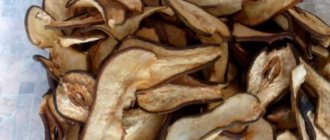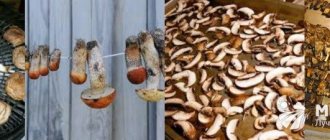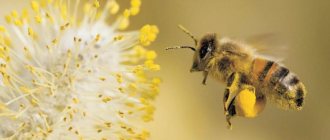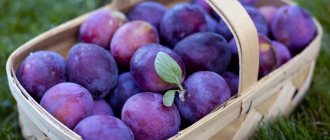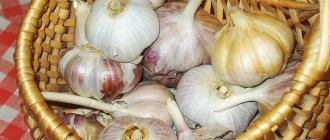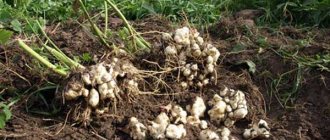Storage conditions for comb honey
Honey has good preservative properties and can be stored for a long time. But despite this, there are a number of conditions that must be adhered to.
The rules for storing honey in honeycombs are practically no different from the storage conditions for a product packaged in glass containers (an article on this topic is here). However, preserving comb honey is somewhat more difficult. To understand how to preserve honey in honeycombs, you must first understand what affects its preservation:
- humidity;
- temperature;
- access to sunlight;
- neighboring products.
One of the factors that negatively affects the shelf life of honey is sunlight . Under the sun's rays, the product's vitamins and some enzymes begin to degrade. The first signs of damage can be detected within a few days. Therefore, honeycombs must be stored in a dark place.
High humidity also promotes rapid spoilage. Honey is hygroscopic, that is, it absorbs moisture well, which leads to fermentation of the product. The most optimal humidity level for storage is no more than 70%.
Temperature conditions. The product can deteriorate at both low and high temperatures. It is believed that mature honey, with a water content of less than 17%, is best stored at temperatures from +5 to +20°C. Unripe product with a water content of more than 17% is recommended to be stored at a temperature of +5 to +10°C.
It is not recommended to freeze honeycombs, as the wax becomes brittle, which leads to cracking of the honeycombs and, after thawing, the honey may leak out. The product is negatively affected not only by low and high temperatures, but also by sudden changes of more than 10 degrees - this leads to the formation of condensation and molding of the honeycombs.
Storage rules
In order to preserve the beneficial properties of such a medicinal product for a long time, you need to know how to properly store honey in honeycombs:
- Large honeycombs should be divided into several smaller parts. This condition will allow them to be preserved, even in the smallest rooms. This condition ensures a longer shelf life.
- It is better to place the honeycombs in glass containers. Plastic or iron may negatively affect the shelf life of the product.
- It is recommended to store honey in combs in a cool, but not too cold place. It is best to use a refrigerator.
- Do not place the substance near other food products, because it can absorb all extraneous aromas.
- It is strictly forbidden to freeze the product. Frost may cause the natural print to peel off. If air gets in, the honey will begin to crystallize and spoil.
- If you are going to store the goods at home (at home or apartment), separate refrigeration units are used for it. This will protect it from foreign odors.
- The honeycomb storage facility must have a normal temperature (no more than 5 and no less than -5°C). Under such conditions, the product can be stored for a long time (about 10 months).
Plastic containers
Often plastic containers rather than glass are used for storage at home. Thanks to the presence of the lid, foreign odors do not penetrate inside, which significantly preserves the smell. They have a positive effect on the shelf life of the natural product. It can be stored in them for about a year without changing its consistency or aroma.
If storing honey in honeycombs at home, it is important to adhere to the temperature regime. It should not exceed 20°C. As the temperature rises, the honeycombs begin to deteriorate faster.
Fridge
Cellular products are placed in the refrigerator to preserve all the beneficial properties.
Refrigerators are always clean and have low humidity. These parameters have a great impact on the quality of the product. If you store the product in proper conditions, then in winter you will be able to enjoy a tasty and healthy substance that will protect you from colds and other diseases.
Honeycombs can be stored in the refrigerator
Where to store
Considering that the ideal temperature for storage does not exceed 10 degrees, there are not many options for where to store comb honey. For example, in a country house or in a private house there is often a basement or cellar . The temperature in them, even in summer, does not exceed +10-15 degrees, which is the norm for storing this product. However, these rooms have a drawback - high humidity.
Many cellars, especially in spring and rainy autumn, flood, and fungus and mold often grow on the walls. Plus, don’t forget about pests. Somewhere there may be slugs, and somewhere there may be wax moths, the larvae of which love to feast on both honey and wax. Therefore, it is recommended to store honeycombs only in dry and pest-free basements. Moreover, the product must be in an airtight container.
In a city apartment, the most suitable place to store delicacies is the refrigerator, namely the vegetable compartment. However, to prevent honey from absorbing odors and excess moisture, it must also be stored in an airtight container.
Definition of infestation
Identification and destruction of the pest is mandatory, as it causes enormous harm to both bees and the beekeeper. The larvae gnaw out passages in the honeycombs, enveloping them in sticky threads, so young bees are not able to get out on their own. Older individuals are capable of gnawing out honeycombs, but the wings and legs of young insects are already shrouded in white cobwebs. They are unable to move, and as a result they die. Therefore, first of all, you need to pay attention to the number of dead individuals. If there are a lot of them, then an infection can be suspected.
It is worth paying attention to other factors:
- Presence of wax moth droppings.
- The bees began to work several times less, although before this there was stable activity.
- Presence of larvae at the bottom of the bee home.
- The insects have moved from the hive to the edge of the entrance, but are in no hurry to collect nectar.
- Presence of a web. It is worth paying attention to the bees' paws or removing the cover and checking for the presence or absence of cobwebs between the honeycombs.
It is important to understand what causes the appearance of wax moths and their larvae:
- The weakness of the bee colony, its lack of strength to resist pests and other irritants.
- There is an increased percentage of humidity in the hive.
- High humidity outside the bee house for a long time.
- Absence of a queen in a bee colony. The result is an accumulation of beebread due to the reluctance of insects to clean the hive.
- Dirt in the honeycombs, which is most often the main cause of pests.
- The temperature in the winter hut is high.
- A large number of dead individuals in a bee house.
Cleanliness should be paramount; it will protect the bee colony, protect it from pests and possible death, so the beekeeper should not be negligent in this activity.
What is the best way to store it?
To store honey in honeycombs at home, you can use various containers. Previously, earthenware was actively used for these purposes. It protected well from moisture, sunlight and pests. But today, finding large ceramic storage vessels is quite difficult. You can use other, more accessible options:
- glass is the most common material. Glass jars do not emit toxic or other harmful substances, and also do not react with the contents of the container. The main disadvantage of the material is its transparency, which facilitates the penetration of sunlight. But this drawback is easily eliminated by wrapping it in paper or food foil;
- plastic containers – you can use containers made only from food-grade plastic. The disadvantage of this material is that in the cold it becomes brittle, and when exposed to direct sunlight it begins to release harmful substances. Therefore, it is recommended to use such dishes for temporary storage;
- wood – wooden barrels or containers are a good alternative to glass. But it is worth considering the fact that dishes made from coniferous wood contain essential oils that can affect the aroma of honey. Therefore, it is recommended to choose products made from birch, alder or linden.
Features of containers
Honey, like all natural products, has the ability to absorb moisture and odor. For storage, you need dishes that exclude contact with these factors and prevent oxidation of the product. The high content of active substances requires neutral, chemical-resistant containers. A good option is glassware, preferably dark glass. Wooden, ceramic containers, and food-grade plastic are also suitable. Before storage, the container must be thoroughly washed and dried. It is unacceptable to pour fresh honey into a container containing the remnants of last year’s harvest. The lid should fit tightly, preserving the product in its original state.
Glassware
Glass is the most popular material for making containers. It does not enter into any chemical reaction and does not affect the taste and aroma of the contents. Disadvantages: fragility, light transmission and heavy weight.
Potato variety Elmundo: description, cultivation techniques and care
Plastic box
Plastic containers are in great demand; they are light, durable and cheap. Plastic must be certified for food storage and have markings confirming that it is safe polypropylene (PP, PP). It would be a good idea to check the container for smell - a strong, chemical smell indicates that it is unsuitable for food.
Vessels made of wood
Previously, linden barrels were the most common container for amber nectar. Other types of wood are not suitable. In an oak container, the healing sweetness will darken; in a pine container, it will deteriorate hopelessly due to the high resin content and the presence of a strong aroma of pine needles. The inside of the wood is coated with a layer of wax to limit the flow of oxygen. Traditionally, honey in Russia is kept in small vessels made of birch bark - tues. Birch bark is not afraid of moisture and mold, and has the property of keeping the inside of the vessel cool.
Metal container
Metal containers are least suitable. Aluminum and galvanized utensils, under the influence of active acids contained in honey, release harmful and even toxic compounds. The only acceptable option is enameled metal containers. The coating is resistant to oxidation processes. An important point is that it should not be damaged or chipped.
Honey is a gift from Nature to man, allowing him to maintain and improve health. This bee waste product is a tasty medicine that contains so many essential substances and compounds that their loss in the process of inept preservation will be irreplaceable. A high-quality, seasoned product competes well with drugs used in traditional medicine and forms the basis of many cosmetic preparations.
Shelf life of comb honey
Many people still argue about how long honey can be stored in honeycombs. There is an opinion that it can be stored for decades. However, experts do not agree with this statement. Recent studies have shown that honey loses almost 20% of its beneficial properties every year. Therefore, it is recommended to store the product:
- at room temperature – no more than 6 months;
- in the refrigerator - no more than 1 year.
In Egypt, when excavating tombs, honey is often found. It was used both as a preservative and as an offering to the gods. According to archaeologists, the product often looks like it can be eaten even after thousands of years.
Only in state reserve warehouses is storage of the product allowed for up to 2 years. In any case, honey in combs is a product that has a limited shelf life, which is why it is better to consume it before the end of winter.
How to properly store honeycombs at home: conditions and rules
Bees, guided by instinct, build honeycombs - special cells made of wax. Then they fill them with healing, nutritious nectar collected from meadow flowers. By processing pollen into sweet honey, the bees saturate it with essential enzymes, and the honeycombs themselves are made from medicinal propolis, wax and dead bees.
The tasty, healthy box created by the winged worker is sealed. The most valuable nectar hidden inside retains its properties for a long time, and man’s only task is to take, preserve and use this priceless gift of nature.
Experienced beekeepers who do not cheat and do not feed bees sugar will be happy to tell you how to store honey in honeycombs. To begin with, in the spring they will carefully remove the frames without breaking the delicate structure. Then the sweet briquettes will be packaged in a special container and given to good hands for a fee. The beekeepers will also share useful tips that will definitely be useful to all buyers of honeycomb nectar.
Conditions for expanding nests
You can expand the nest in various ways:
- Increase the number of cells.
- Install additional magazine extensions.
- Unite the bee colony in case of two-queen keeping.
Nest expansion is best done in the spring.
It is necessary to expand nests in the spring, when the bee colony urgently needs additional space. This is also preparation for the main bribe. It is necessary to add dry frames in a timely manner and in the right quantity. Otherwise, the nest may become hypothermic and lag behind in development.
It is also recommended to expand nests when there is a large amount of brood in them. In this case, the seeding of the uterus should be on the outermost frame. If larvae appear on the edge of the frame, or the bees end up behind the screen board, it is necessary to add frames with dry material.
It is necessary to expand nests when there is a large amount of brood in the nests. If printed brood or larvae appear on the outer frame, it is necessary to urgently dry it. If bees appear behind the screen board, the nest should also be expanded. When expanding nests, the beekeeper should carefully inspect the hive once a week, adding dry matter to various places in the hive.
Please note: the fresh frame should not be separated from the one with the brood, as it may cool down.
